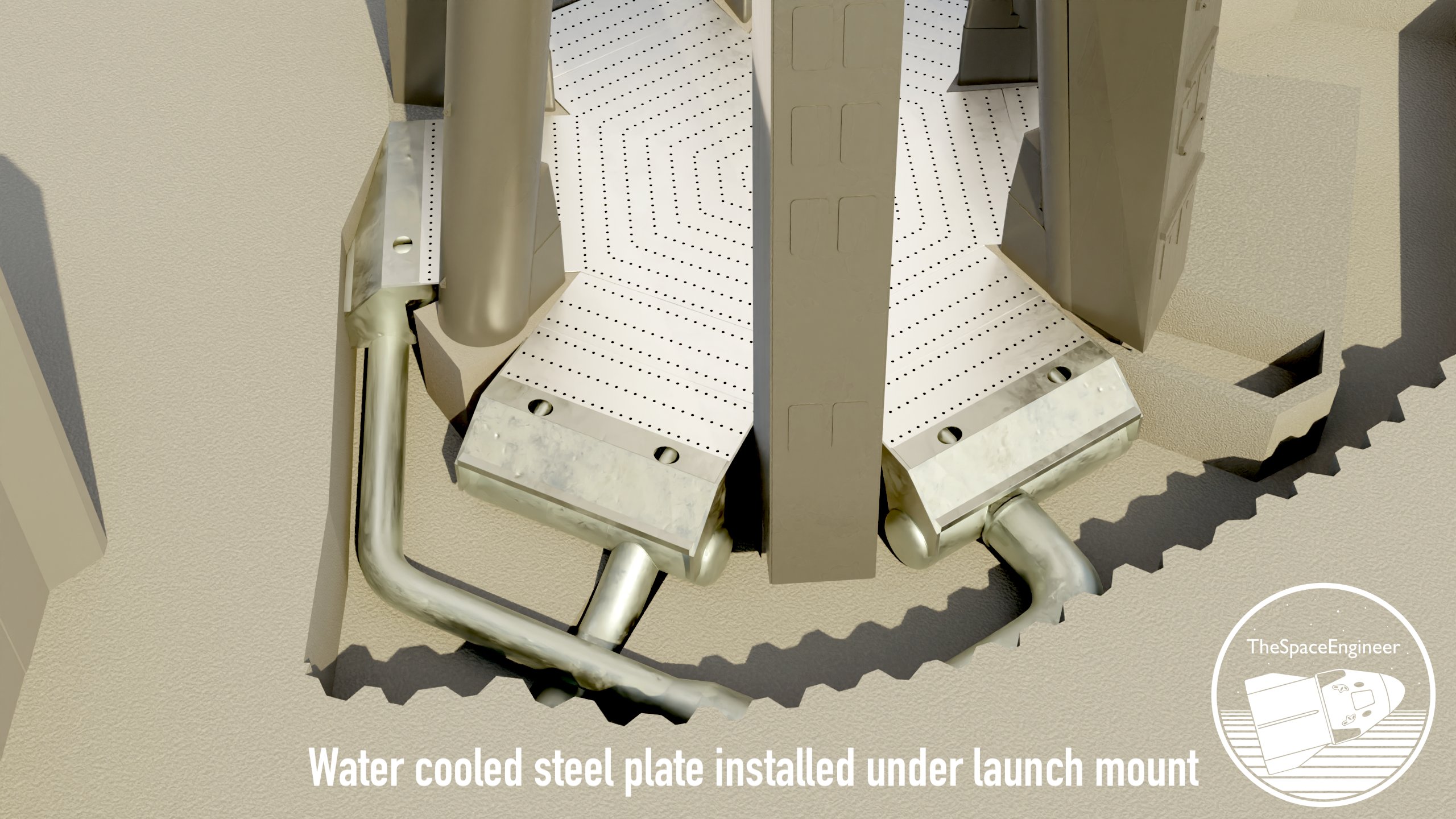(bolding mine)
is that due to the Leidenfrost effect?
(bolding mine)
is that due to the Leidenfrost effect?
I’m not actually sure, but I don’t think so. I think it’s pumping so much water that’s being flashed into steam, carrying heat away, that very little heat is actually reaching the plate. But I haven’t seen a good technical description of what’s going on. Maybe one of the other participants has.
It’s not exactly the Leidenfrost effect, but it’s the same basic idea at play. When the water flashes to steam, it acts as an insulating barrier and pushes the two things away from each other. With Starship, you have the launch mount emitting water, a massive heat source coming from above, and a layer of steam between them. The steam itself will have some thermal gradient, since it’ll be the temperature of the rocket exhaust at the top, and 100 C at the point where the water is evaporating. So it protects the launch mount itself by keeping the temperatures low. Some of the steam will squirt out the sides and have to be replaced with more water, but it probably won’t take all that much, all things considered.
There are some quite large pieces of metal being moved around at Starbase:

It might be a little hard to work out the geometry from these angles, but basically these and other pieces will look something like this when installed:

In that first shot, the flat plat was so large that it couldn’t just be slid under the launch mount when installed. Nor could it be fed down from above. Instead, it got tilted up, and then cables from a crane were lowered down and attached, and now they’re going to slowly tilt it back down to flat.
Every time I see a pic like the first one of a gigantic hunk of something heavy and a crane, while guys in hard-hats look up at the stuff I can’t help but think: “That hat ain’t gonna save you.”
Of course I understand the very real value of hard hats on construction sites. But there’s just something comedic (to me) about the sheer disproportionality of the offense vs. defense right there.
Heh, yeah. I’m not even sure the helmet will do much against a socket wrench dropped from the top of the mount, let alone the giant steel thing flopping down. Not to mention the helmet not doing much when you have your head tilted back like that. But I’m all in favor of being in the habit of using safety gear no matter what…
Water, water everywhere, nor any drop to drink:
This seems… sufficient.
Insane that they did a launch without a system of that sort. NASA has been doing this stuff forever. Image from 19 years ago, but Saturn had a similar system in the 60’s.
They had pretty thick pad of high-strength, heat-resistant concrete. They were only hoping it would last that first launch, and had already been assembling this system.
The actual failure was somewhat unusual. The rockets didn’t just erode through the whole pad. They applied enough force to crack the pad and cause bearing failure–that is, so much force that the dirt and piles supporting the pad could not bear the load any further. The soil shifted, the crack expanded, and the plume then flowed under the pad, lifting it up in large chunks. The failure cascaded from there.
This system isn’t exactly like what NASA uses. NASA’s system has more lateral flow, where the water shoots in from the side. But the SpaceX system is an “upside-down shower head”, as Musk puts it. Water shoots directly up from holes in the pad, keeping the rocket plume from directly impacting it.
It’ll need to push the water out with enough force to resist the plume. Current calcs are that it needs about 16 atmospheres (certainly within the realm of what’s reasonable).
I keep wondering if they are substituting giant flying chinks of molten metal instead of gravel…
Based on the amount of water coming out, that seems very unlikely. Water flashing to steam can carry away quite a lot of energy.
It’s possible they could suffer another bearing failure: either the soil again, or the steel pancake. But they significantly beefed up the concrete base, and a fully engineered system like the steel pancake should have more predictable behavior than the soil.
Again, they knew the previous system was borderline, but thought it could make it through one launch. The new system was already going to be significantly beefier, plus they have a lot more knowledge about the rest of it now. I’d be more concerned about the steam flow damaging surrounding infrastructure. Ultra-hot steam at kilometers per second isn’t that great for things.
Is the water shooting up high enough to actually hit the engines? I wonder if they will do a full static fire with water deluge running. I would assume so.
NASA always started the water deluge just before ignition. It’ll be interesting to see if this system can also be started before ignition, or whether they’ll need some sequence like ignition->water deluge->throttle up.
There’s a limited supply of water and gas pressurant (nitrogen, I think). The pad needs to survive for around 10 seconds, and they’ll undoubtedly time things so that the water starts just before ignition and runs until depletion. Engine ignition is timed to <100 ms, and the water will probably be close to that, so they can undoubtedly time things as close as required.
The water in the video doesn’t reach the top of the mount. I don’t think they’d want that anyway. The requirement is that the water pressure exceeds the stagnation pressure of the exhaust. That is, although the exhaust leaves the nozzle at close to 1 atmosphere, it is traveling at a high speed. There is another, higher pressure that is required to slow down and stop the exhaust (stagnation). And the base plate needs to exceed that so the exhaust doesn’t travel into the holes and back into the system. Informed people seem to think this is around 16 atmospheres.
However, this says nothing about how high the water reaches. The holes could be very small and only emit a slow-moving stream. Or, they could be large and create a huge fountain. From the video, it seems like it goes up about halfway, and is also angled outward.
It seems a good bet that they’ll use the system during a static fire, but I don’t think anyone knows for sure. It’s just water and gas, though; it’s cheap to recycle.
I wonder how much of the water suppression system is intended to help damp acoustic energy. Initially SpaceX seemed to also feel that they could weather the reflected energy. But they have been reversing quite a bit of their bullishness. So it may be that water flows are not just about cooling the steel plate but are at a volume that dissipates at least some of the acoustic energy.
I was wondering the same. Last time we had the “rock tornado” causing major damage. I’m wondering if that might have masked somewhat damage that would have also happened from all the acoustic chaos.
I’m not sure what effect this system has on the acoustics. My intuition is that it’s not a big deal in general due to the geometry. Acoustic energy can’t possibly be reflected directly up, because there is a cylinder of hypersonic gas going in the opposite direction. So the only place it can go is sideways, but then it can’t damage anything on the rocket itself unless there is a reflection off of some ground infrastructure. And it will be attenuated quite a bit if so.
The rocknado took a few seconds to form, but in the meantime we should have seen some serious damage to the heat tiles if acoustic reflections were an issue (since those are the most delicate parts). That didn’t seem to be a problem.
Flame trenches can actually be worse for acoustics, because they move the energy from under the rocket (where it can’t actually damage anything), so some distant point where the waves can impact the rocket from the side.
Like we could tell? Also: heat tiles? I’m sure there was some Potemkin heat tile system, but wasn’t the flight plan to flop and let it crash in the ocean? Were heat tiles even a serious thing that last flight?
And the heat tiles were waaay up high on the vehicle, second stage. Damage to them would be extraordinary, no?
We would have noticed. Plenty of folks had serious cameras trained on the Starship and there wasn’t any great loss.
We have seen lots of tiles lost in previous Starship static fire attempts. They aren’t hard to miss. I think just the vibration though the airframe is enough to dislodge them in some cases.
The tiles themselves are surely sufficient–that’s well-established technology. Keeping them attached will be the trick. But they have gotten better at this.
And yeah, damage that high up would be extraordinary. But that’s basically the point. The acoustic energy doesn’t have a line of sight to anywhere else. And most of the outside doesn’t have anything fragile on it.
An earlier static fire (should go to the right time):
You can see several bits falling away, leaving bright spots among the rest of the heat shield. Airframe vibration or external acoustic energy? Couldn’t say. But the tile attachment leaves something to be desired. It’s not as bad when it’s stacked way up on Superheavy, though.
Watching that video again, the water didn’t look directed upward to me. More like this, up and outward:
I mean, it’s hard to tell ¯\_(ツ)_/¯ maybe the streams pushed each other outward, but that’s still a concern I’d think.
Thanks for the commentary on the tiles. It was tough to see the tiles fall away and I really didn’t, but I could see the “pixels” where they were gone.